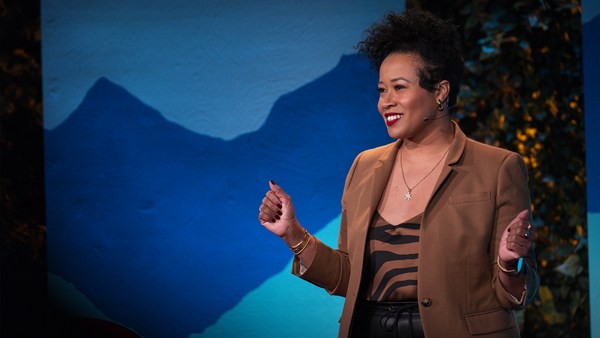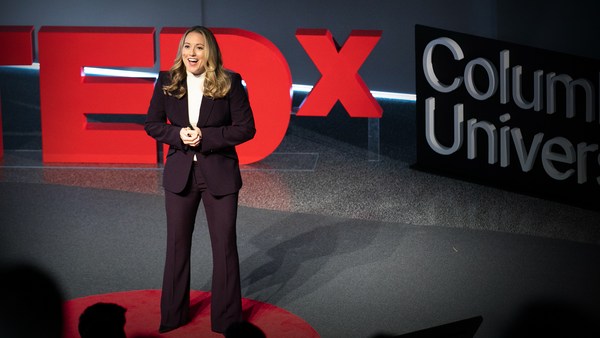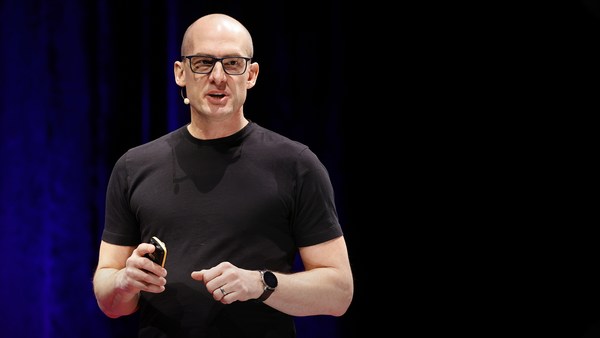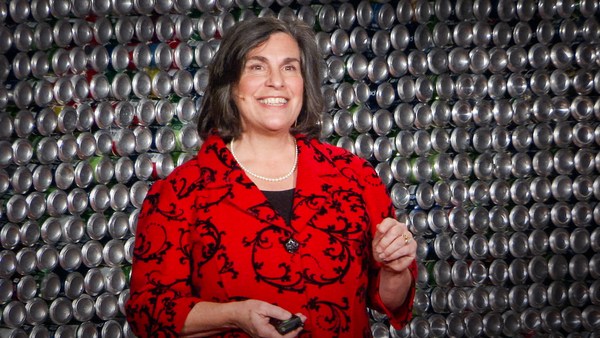I'm Paolo Gaudiano and I always like to start by addressing a couple of elephants in the room. The first one is the white elephant and it's me.
(Laughter)
What is a white, cisgender, heterosexual, fully privileged guy doing talking about diversity and inclusion? Now, normally I tell people about my history, how I was really interested in diversity, inclusion, how eight years ago I figured out that I could actually tie my research work to find a way to have a proper impact. So I feel a bit like an imposter being here today, but I hope that you'll just let me get away with that.
Now, the second elephant in the room is that I’m making this a little bit lighthearted start. But the reality is that there is major backlash going on against DEI right now. And I think that's a huge problem. And I want to tell you about some of the research that I've done and how it leads me to understand why we're seeing the backlash, because I think that until we really understand it, it's going to be very difficult to make progress.
I believe that one of the reasons, unfortunately, why we're seeing the backlash is because for five decades now, or more, people in business that have been talking about DEI have been focused entirely on the D. I call it the diversity disconnect. We focus entirely on representation, and we sometimes forget about the E and the I. And this, however, is a very big problem. Because the D actually creates a few problems, including backlash. And let me explain what I mean by that.
First of all, the D is a problem because we don't have any tools that can tell us for one organization what will happen if they make the organization more diverse. Which is very interesting, because if you think about other areas where we manage assets, and I like to think of people in a company as being assets, we know that diversification works. We diversify our financial assets so that we make more money. We diversify our marketing assets so that we sell more products. But if I were to go to a company that was primarily white and male, and I asked them what will happen if I could wave my magic wand and turn half of the people into people of color or into women, "What would happen to your organization?" And the answer is, "We don't know, because we have no tools that can help us to quantify the impact of diversifying our human assets."
But there is a second problem, which is that unfortunately, the focus on diversity tends to drive backlash because it leads to accusations of reverse discrimination. Now you all should be rolling your eyeballs here,
(Laughter)
and you'd have very good reason to do that. However, I want you to think about it from the perspective of the people that look like me. My CEO just got up on stage today with the chief diversity officer, and they said, "We have this new plan. We're going to increase the number of people of color in our company by five percent, and the number of women by 10 percent in three years." And you do a quick math and you say, "Well, that means you're going to be eliminating 15 percent white men." And how is that fair? And you can tell me about all the injustices all you want. But the fact is, it is unfair and it is discrimination.
But it turns out that that's the wrong argument. But it's not the wrong argument because people are interpreting it wrong. It's because the very foundation is flawed.
The reason why we need more people of color and more women in organizations is not because we need to stuff more people into the entry level. It's not because we need to go and get a bunch of kids from HBCUs and invite them into our company to make those numbers look good, only to find out that their manager doesn't know how to deal with them, their leadership doesn't look anything like them, and then they will turn around and leave. No, the reason why we have problems is because when those people get into the organization, they don't stay.
McKinsey just released their annual study, and they found that when you look at the ratio of white men, white women, women of color and men of color in an organization at the entry level you have roughly 40 some odd percent white men, maybe 35 percent, and so on and so forth. By the time you get to the executive level, the number of white men has increased by more than 30 percent. The number of women and people of color has decreased by more than 30 percent, which means that for us to continue to try to stuff people in at the entry levels when our companies are not inclusive, is a waste of time. And trying to solve the problem by arguing that we should have higher ratios, and setting targets at the company level is a mistake, because you're not addressing the problem.
I like to joke about the fact that it's as if I walked in the house one day in the wintertime, and I found that it was very cold. Actually, it's very cold in here today. I look at the thermostat and I say, "Oh my God, look, it says 50 degrees. I know how to fix that." I light a match under the thermostat and look, the thermostat now reads 90 degrees, but in the meantime, the windows are open, the front door is drafty, and the roof is leaking.
The problem that we have with diversity, equity and inclusion leads to what I think of as the definition of DEI. Inclusion is about what we do as an organization. Diversity is what we get. In other words, we have to stop trying to fix the symptoms and actually understand what the real problems are. I will also tell you in a minute why I think that equity is what we want. I'll come back to that in a moment.
But let's talk about that idea, inclusion is what you do. Imagine a team that's the perfect team. You cannot get any more performance out of it because each individual performs at their peak. And as a team they perform really, really well together. And imagine that now something happens so that one of the people on the team is unable to perform at their peak. What will happen to the performance of the team as a whole? It will decline.
Suppose that now a second person is unable to perform at their peak. Not only is the team going to lose more performance because of the loss of the second individual, but the rest of the team is going to get frustrated because they have to pick up the slack, because they'll be late on delivering a project and their manager will no longer give them the best projects. That means that pretty soon the performance of the entire team will decline dramatically because of that problem.
Now, I didn't say anything about what the people on the team look like, or what they did or why they were not able to work, but it leads to a profoundly important conclusion. Anything that any organization does that causes someone to feel excluded because of their personal characteristics is shooting themselves in the foot. This is a very important point.
(Applause)
This is why the third part, which is the equity, is what you want. If you have an organization in which you have people that are treated differently and you see it because you see that the retention rates are not the same, that the performance is not the same, you are witnessing inequity. You’re witnessing inthe difference in the outcomes that people experience within your organization. When you see that happen it means that there are people that are performing below their peak. And just like that example that I gave you, it means that you're making less money because you have less productivity.
It also means that those people do not feel that they belong in your organization, and they're going to leave. If the retention rate of men in your organization is 90 percent, but the retention of women is only 80 percent, that means that you're losing 10 percent too many women. If your company has 1,000 women, which is not a very big company, and you're paying them an average of 100,000 dollars a year, and we know that it costs about one year's salary to replace them, it means that you have lost 100 people, and it's going to cost you 100,000 dollars each. That's 10 million dollars a year that you're throwing out the window because you're not treating women inclusively. And the same is true of people of color, people with disabilities, LGBTQ.
We have created a way of measuring inclusion, and this is where things get really interesting. Why are people so obsessed with measuring diversity only? Because it turns out that really, we talk about DEI, but look outside, look around you, look at any company they just measure the D. Why? Reason number one, because it's much easier to define, right? You just ask people, do you belong in this or that category and you count them.
When it comes to inclusion, the most popular definition that I've heard, and there are many out there, was the one given by Vernā Myers, formerly of Netflix, who said, "Diversity is being invited to a party. Inclusion is being asked to dance." I love the definition because it's very intuitive, but if you're running a company, unless it's a party company, it's not going to help you very much.
When it came to understanding what I told you earlier, that inclusion is about what you do and diversity is what you get, and we started to investigate that, we realized something profoundly important. Inclusion is invisible. It's just like privilege, we don't see it, those of us that are fortunate enough to have it. And I use the analogy with health. When I introduced myself, I didn't say, "Hi, I'm Paolo, I'm very healthy today." But if I'd been coughing, if I just had COVID if I had had, I don't know, a few years ago I fell off a bike and I had a cast on my shoulder, I might have said something about it. We don't notice when we're healthy, we notice when we're sick. We don't tend to notice when we're included, but we sure as hell notice when we're being excluded. And we've heard a lot of examples from the other speakers about situations in which people felt excluded.
What does that tell you? Well, something very important. If you're very healthy, you tend not to know a lot about diseases. You may not even know the names of the diseases. You don't know the symptoms. You certainly don't know how to cure them. So similarly, if you're very included, you don't know what exclusion means, you don't know the symptoms, and you sure as hell don't know how to fix it. However, if I were to ask people in this audience if anybody in this audience has ever been sick, probably all of you know what that's like. But if you go in a company and you find out who are the people that are the most included, it's the leaders, it's the ones that look like me who are the least qualified to understand it, to see it, and most importantly, to know what they should do about it. And this is a profound problem. I firmly believe that it's not necessarily that white leaders are evil, and they want to keep the power that they've worked so hard to grab. Yes, some of them do that, there's no question about it. But a lot of them would love to do the right thing, they just don't know how, they don't see it.
So my organization helps them to do that by measuring inclusion. And the way that we do that is actually by measuring exclusion. We do workshops in which we talk about some of this work. We show these computer simulations that show relationship between what happens in a company and how the company actually looks and performs, and then we ask them, using a confidential online platform, to share specific things that have happened to them, that have made them feel uncomfortable in the workplace. And then we also ask them, did this have to do with work-life balance, with compensation, did it have to do with being able to use your skills? And was this something that was because of your manager, leadership or policies? And we get a combination of qualitative data in terms of the descriptions of what happens to people and quantitative data that tells us where to look and who is most impacted.
And I want to read you, I brought with me, three examples. We asked people permission to share some of the stories. I want to tell you about some of the things that people write when we ask them to share experiences. Number one, "After introducing myself, I've had individuals ask to speak to "a guy who works in IT" instead of me." This was a senior engineer, who is a woman, in a cybersecurity firm.
Number two. "I was passed over for travel opportunities because I had young kids at home and it was assumed that I couldn't travel even though I was never asked." We hear this kind of stuff all the time.
Number three. "In a meeting with about 50 people, a vice president said that Martin Luther King Day was not a real holiday and that we shouldn't take the day off."
What's going to happen to these people? They're going to leave and it's going to cost you money and you're going to lose amazing talent.
The last thing I want to leave you with is a number. Thirty. Thirty is the ratio between how much money every company in the United States spends in one year on advertising, all forms of advertising. We spend a lot of money advertising. Two hundred and fifty billion dollars a year. When we look at payroll for the same companies, not all labor costs, just payroll, 7.5 trillion dollars a year, 30 times as much. So if you are the CEO of an organization and you have ten people that work on optimizing your marketing, you should have 300 people working in DEI. And if you're not doing that -- thank you.
(Applause)
If you are not doing that, you are failing your responsibility as a leader to your shareholders. So I don't care whether you do it because you think it's the right thing to do, or because you think it's the right business choice to make.
But what I'm going to ask everybody out there is be mindful of the fact that when we think about DEI, we need to realize that it's not that diversity impacts performance, it's that creating a more inclusive organization is going to lead to organizations that are more diverse, more equitable and make more money.
Thank you.
(Applause)





